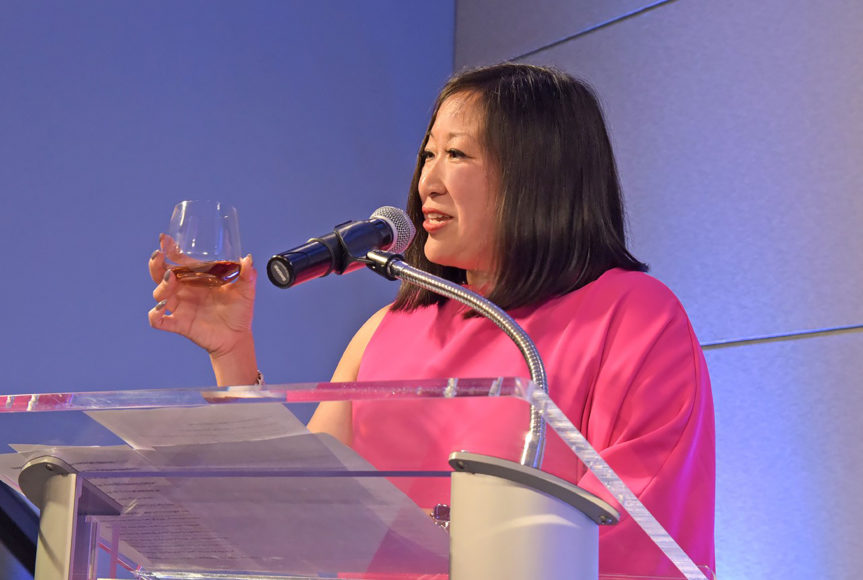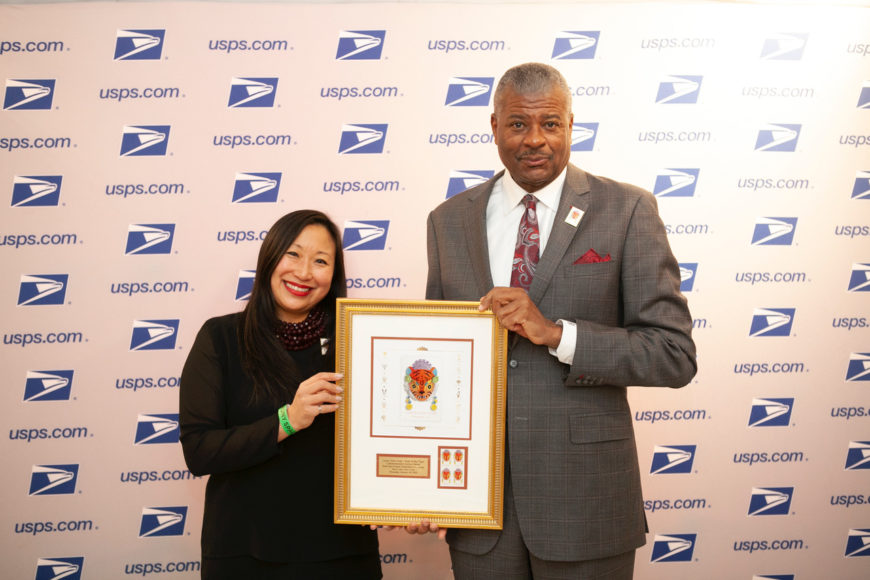If there is one word that describes Michelle Yun Mapplethorpe and her career in the visual arts, it is “global.” As Asia Society’s vice president for Global Artistic Programs at the society’s 14 centers, director of the society’s museum and co-founding artistic director of its triennial, Yun Mapplethorpe has bridged East and West for more than a decade. Now she looks to continue that international outreach at the Katonah Museum of Art as its new executive director, beginning Aug. 15. She follows Leslie Griesbach Schultz, who has served as interim executive director since September 2021, and succeeds Michael Gitlitz, who concluded his three-year tenure as executive director in June 2021.
“I feel artists are the mirrors of their time, and they raise that mirror to what’s going on around them,” she says. “The way people react to art is so personal, very powerful…and it brings people closer together.”
Given what Yun Mapplethorpe sees as the centrality of art to social discourse and her admiration for the Katonah Museum — a noncollecting institution with a $1.95 million operating budget and 19 staffers that offers an array of exhibits and programs — it’s not surprising that she is looking to broaden the museum’s presence on the world stage. And while it’s premature to discuss specifics, she says it’s fair to say that will include new marketing initiatives and outreach to business leaders.
“We moved (from New York City) to Weston in 2017,” Yun Mapplethorpe says of herself, her husband, photographer Edward Mapplethorpe, and their 7-year-old son. “Being out here and seeing how our own community is hungry for art and culture, I’m really hoping to tap into these communities.” One way she will do that is at the Katonah Museum’s fall gala at Blue Hill at Stone Barns in Pocantico Hills.
In the meantime, she will be taking the helm of a museum that is unique in our region. Founded in 1954 in the Katonah Village Library as the Katonah Gallery — the museum changed its name in 1990 when it moved to its modern, Edward Larrabee Barnes-designed home on Route 22 at Jay Street — the KMA does not maintain a collection but nonetheless presents exhibits and related educational programs spanning various cultures, periods and media. From July 10 through Sept. 25, the museum offers two shows with an international spotlight. “Tradition Interrupted” finds a dozen artists from around the world teaching old media new techniques as they marry past and present. “Remy Jungerman: Higher Ground” has the Suriname-born Dutch artist, who divides his time between Amsterdam and what was once New Amsterdam (New York City) presenting new examples of his “horizontals” and “verticals” (assemblages that hang on the wall or stand freely respectively); stacked “cubes” and fabric-covered “panels.” These shows join The Rothko Room, a meditative space that salutes the great color-field painter Mark Rothko with his “Untitled” (1969), and two outdoor sculptures by Manolo Valdés (through March 13) that echo art history — “Caballero,” inspired by Diego Velázquez’s equestrian portrait of Spain’s Philip IV; and “Butterflies,” a nod to Henri Matisse’s painting “Woman With a Hat.”
Meanwhile, Asia Society Museum in Manhattan is presenting one of its last major shows under Yun Mapplethorpe’s leadership. “Mirror Image: A Transformation of Chinese Identity” (through Aug. 14) considers 19 works by seven artists of the ba ling hou generation. Born in China in the 1980s, they came of age in a post-Mao Zedong period of Western-influenced, economic expansion even as they saw the results of a one-child policy that selected for boys, leaving whole generations of men with too-few Chinese women to marry and putting those women and foreign brides from countries like Vietnam unexpectedly in the driver’s seat. (In Chinese culture, a son has been seen as more desirable than a daughter in part because he would care for the parents in their old age.)
The overall effect, Yun Mapplethorpe says, is that the ba ling hou generation sees itself as part of a global contingent. It’s a fitting Asia Society swan song for Yun Mapplethorpe, who has bridged China and the United States in her personal as well as professional lives. Her parents left mainland China in the 1950s — her father for Taipei, Taiwan; her mother for Hong Kong. Eventually, they made their way separately to the United States where they met at the University of Michigan. Growing up in Michigan and Toronto, Yun Mapplethorpe had the kind of childhood that has helped define Asian Americans as “the model minority,” including exposure to the arts in places like the Detroit Institute of Arts. This was particularly true during her high-school years at the Cranbrook Schools in Bloomfield Hills, Michigan, a group of prekindergarten through 12-grade preparatory schools known for their rigor in the arts as well as in academics, Yun Mapplethorpe says.
At Mount Holyoke College in South Hadley, Massachusetts, where she earned a Bachelor of Arts degree, she spent her junior year abroad studying art history. (Today, she’s on the board of the college’s art museum.) Yun Mapplethorpe would go on to nine years at The Museum of Modern Art, first as a fellow and ultimately as a curatorial assistant in MoMA’s Department of Painting and Sculpture, where she had some of the most important mentor-mentee experiences of her career. During that time, she earned her Master of Arts degree in modern art and critical studies at Columbia University. (She’s also a graduate of the Getty Leadership Institute’s Executive Education Program for Museum Leaders.)
But always the Eastern part of her identity was calling her. She did her master’s thesis on two Chinese artists — printmaker and installation artist Xu Bing and multimedia artist Cai Guo-Qiang, who served as director of visual and special effects for the opening and closing ceremonies for the 2008 Beijing Olympics. Working for Cai as project director of his studio, Yun Mapplethorpe got to be part of the games, an experience she describes as “pretty spectacular. I even went to the gold-medal women’s soccer match between the United States and Brazil.” (The U.S. won, 1-0.)
A stint at Pace Prints in Manhattan convinced her that “I was not meant to be in the commercial world.” She served as a consulting curator in Beijing and curator of the Hunter College Art Galleries, which led to her joining Asia Society as curator of modern and contemporary art. Rising in the ranks, she curated or co-curated more than 25 exhibits as well as developed and led the society’s 2021 Arts & Museum Summit, a three-day global convention that explored reimagined museum treatments of post-colonial narratives.
Her success on two continents — she also visited her parents in Shanghai when her father was part of one of the first China-U.S. business partnerships as an executive with Ford Motor Co. — has given Yun Mapplethorpe a unique perspective on Sino-American relations at a critical juncture. She sees the two countries as perhaps surprisingly similar in some ways.
“People should not look at China as monolithic,” she says. “They should look at it as a very diverse country with so many nuances. It’s a huge country with very sophisticated people.”
She would also like readers to know that the idea of Asian Americans as the “model minority” — entirely upwardly mobile as they send their children to Ivy League schools — is something of a myth. According to the Pew Research Center, Asian Americans have replaced Black Americans as the most economically divided racial or ethnic group in the U.S., with some subgroups doing extremely well while others lag far behind. Covid-19 has exacerbated economic challenges for places like Manhattan’s Chinatown, the highest concentration of Chinese people in the Western Hemisphere, as prejudice has led to store closures, verbal and physical assaults and in some cases even murder.
In the depths of the pandemic, Yun Mapplethorpe, who has commuted into the city regularly — her husband maintains a studio there — says she “felt anxious.”
Now she feels a little better and also thinks the city will rebound from its Covid challenges as part of its cyclical nature.
Still, she says, “Asian Americans need help. They need our support.”
For more, visit katonahmuseum.org and asiasociety.org.






